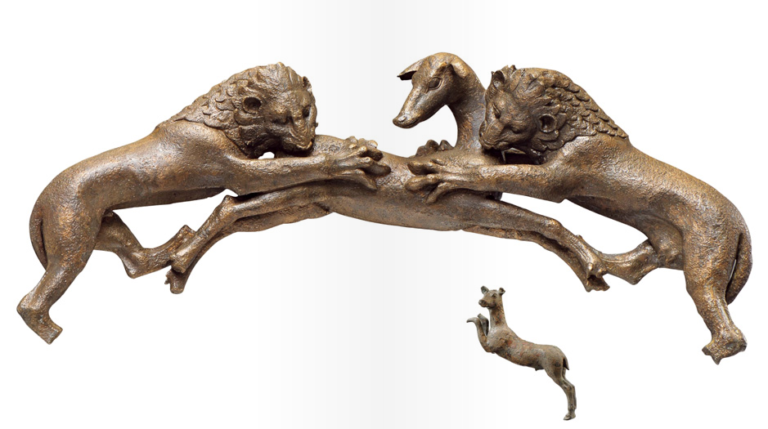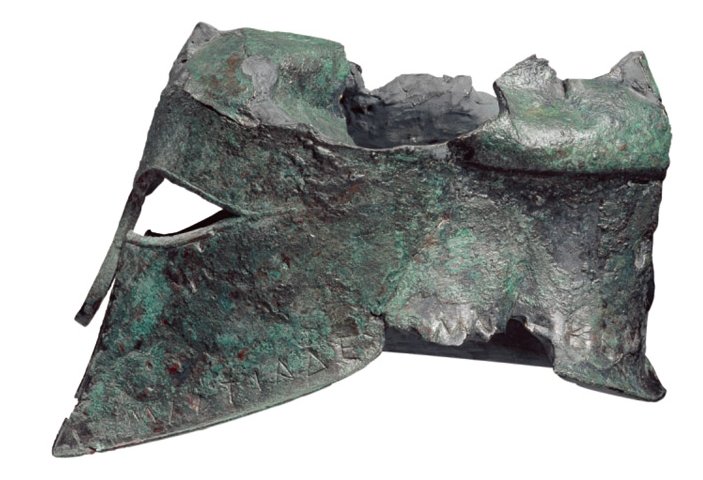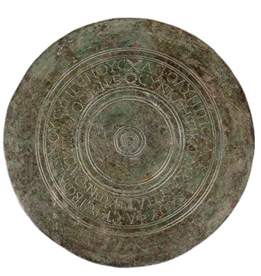γνώρισε....
την πορεία ανάπτυξης του ιερού της Ολυμπίας και παράλληλα την εξέλιξη της αρχαίας ελληνικής τέχνης
Τα εκθέματα παρουσιάζονται στην ευρύχωρη κεντρική αίθουσα και σε έντεκα ακόμη που την περιβάλλουν με χρονολογική και ενίοτε με θεματική σειρά.
Όλα τα αντικείμενα εξηγούνται με απλό αλλά επιστημονικό τρόπο. Με μια ποικιλία χρήσιμων εργαλείων και μέσων όπως χάρτες, σχέδια, φωτογραφίες, ανακατασκευές και μακέτες των μνημείων, ο επισκέπτης ενημερώνεται και υποστηρίζεται σε κάθε του βήμα στο μουσείο.
Οι πίνακες πληροφοριών και οι λεζάντες για κάθε έκθεμα στη βιτρίνα, συζητούν και εξηγούν την ιστορική εξέλιξη τόσο του ιερού όσο και της αρχαίας ελληνικής τέχνης.
Η μεγάλη κεντρική αίθουσα του μουσείου φιλοξενεί το γλυπτό διάκοσμο του Ναού του Διός. Στα υπόλοιπα διαμερίσματα που την πλαισιώνουν, παρουσιάζονται τα πλούσια και συχνά μοναδικά στο είδος τους ευρήματα των ανασκαφών του ιερού της Ολυμπίας όλων των περιόδων, αντικείμενα των συλλογών χαλκίνων, πηλίνων λιθίνων και διαφόρων άλλων υλών του μουσείου.


 The introduction to the history of the sanctuary begins in the first gallery with the finds of the prehistoric period. These include pottery and stone tools mostly of the Early Helladic II and III periods (2700-2000 BC) and finds from the tumulus of Pelops, of which a model is displayed. Terracotta, stone and bronze objects and jewellery from the tholos tombs discovered in the area of the new museum illustrate the Mycenaean period (1600-1100 BC).
The introduction to the history of the sanctuary begins in the first gallery with the finds of the prehistoric period. These include pottery and stone tools mostly of the Early Helladic II and III periods (2700-2000 BC) and finds from the tumulus of Pelops, of which a model is displayed. Terracotta, stone and bronze objects and jewellery from the tholos tombs discovered in the area of the new museum illustrate the Mycenaean period (1600-1100 BC). This unit presents part of the large collection of Geometric and Archaic bronze votive offerings to Zeus, the richest collection of its kind in the world. Figurines of humans and animals, hammered bronze plaques, cauldrons, tripods, several other types of vessels and instruments, griffins and sphinxes, all exquisite examples of bronze work, illustrate the wealth and splendour of Olympia during this period. Equally important are the weapons dedicated to Zeus: helmets, grieves, shield ornaments and ornate cuirasses. Here, too, are the terracotta acroterion from the Heraion and the Archaic stone head of Hera, the visitor’s first introduction to large-scale sculpture.
This unit presents part of the large collection of Geometric and Archaic bronze votive offerings to Zeus, the richest collection of its kind in the world. Figurines of humans and animals, hammered bronze plaques, cauldrons, tripods, several other types of vessels and instruments, griffins and sphinxes, all exquisite examples of bronze work, illustrate the wealth and splendour of Olympia during this period. Equally important are the weapons dedicated to Zeus: helmets, grieves, shield ornaments and ornate cuirasses. Here, too, are the terracotta acroterion from the Heraion and the Archaic stone head of Hera, the visitor’s first introduction to large-scale sculpture. This unit presents pottery, bronze jewellery and vessels, and several important sculptures with painted decoration from various monuments, such as the pediment from the Treasury of Megara, the cornice from the Treasury of Gela and a lion-headed spout.
This unit presents pottery, bronze jewellery and vessels, and several important sculptures with painted decoration from various monuments, such as the pediment from the Treasury of Megara, the cornice from the Treasury of Gela and a lion-headed spout. Several examples of large-scale terracottas, including the important group of Zeus and Ganymides, are presented in this unit, along with a battering ram’s head and the helmets of Miltiades and Hieron.
Several examples of large-scale terracottas, including the important group of Zeus and Ganymides, are presented in this unit, along with a battering ram’s head and the helmets of Miltiades and Hieron. The large central gallery houses the unique marble pedimental sculptures and metopes of the temple of Zeus, the most important exhibits in the museum, all of them characteristic examples of the Severe Style.
The large central gallery houses the unique marble pedimental sculptures and metopes of the temple of Zeus, the most important exhibits in the museum, all of them characteristic examples of the Severe Style. The Nike of Paionios, one of the finest sculptures of the Classical period, comprises this unit.
The Nike of Paionios, one of the finest sculptures of the Classical period, comprises this unit. This unit is dedicated to the sculptor Pheidias and the making of his celebrated chryselephantine statue of Zeus. The unit presents moulds, tools, pottery, the famous cup of Pheidias and other objects from the workshop.
This unit is dedicated to the sculptor Pheidias and the making of his celebrated chryselephantine statue of Zeus. The unit presents moulds, tools, pottery, the famous cup of Pheidias and other objects from the workshop. This exquisite statue by Praxiteles, the finest example of late fourth century BC art, is bathed in natural light from the gallery’s skylights and has anti-seismic protection at its base.
This exquisite statue by Praxiteles, the finest example of late fourth century BC art, is bathed in natural light from the gallery’s skylights and has anti-seismic protection at its base. Η ενότητα αυτή παρουσιάζει κεραμική, γλυπτική και αρχιτεκτονικά στοιχεία της Ύστερης Κλασικής και Ελληνιστικής περιόδου.
Η ενότητα αυτή παρουσιάζει κεραμική, γλυπτική και αρχιτεκτονικά στοιχεία της Ύστερης Κλασικής και Ελληνιστικής περιόδου. The large collection of Roman sculpture is presented here. The fine statuary from the Nymphaion of Herodes Atticus is displayed against a curved wall imitating their original setting.
The large collection of Roman sculpture is presented here. The fine statuary from the Nymphaion of Herodes Atticus is displayed against a curved wall imitating their original setting. This last unit ends the presentation of the sanctuary’s history. It contains objects of terracotta, bronze and iron of the second through to the sixth/seventh centuries AD, when the site was abandoned.
This last unit ends the presentation of the sanctuary’s history. It contains objects of terracotta, bronze and iron of the second through to the sixth/seventh centuries AD, when the site was abandoned.









